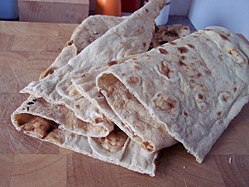 Makki ki roti | |
| Alternative names | Makyachi Bhaakri in Marathi, Mokkajonna Rottelu in Telugu, Makai No Rotlo in Gujarati, [1] Makki di roti/toudaa in Punjabi, Makai ko Roti in Nepali |
|---|---|
| Type | Bread |
| Place of origin | Indian subcontinent |
| Region or state | Jammu, Himachal Pradesh, Punjab, Haryana, Rajasthan, Gujarat, Uttarakhand, and Uttar Pradesh |
| Main ingredients | Corn flour |
Makki ki roti is a flat unleavened bread made from corn meal (maize flour). [2] Like most rotis in the Indian subcontinent, it is baked on a tava .
Contents
It is primarily eaten in the Punjab region of India and Pakistan and in Jammu, Himachal Pradesh, Haryana, Rajasthan, Uttar Pradesh, and Uttarakhand in North India and Gujarat, Maharashtra in Western India and also in Nepal. [3]

